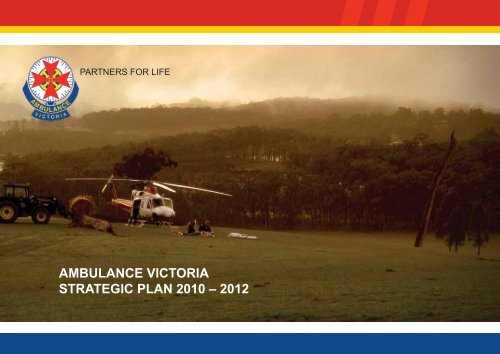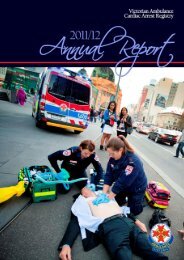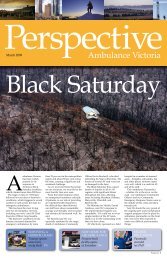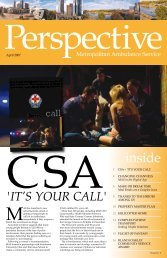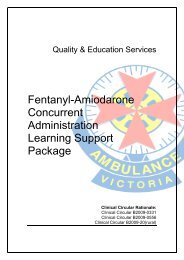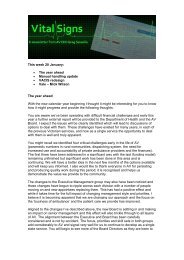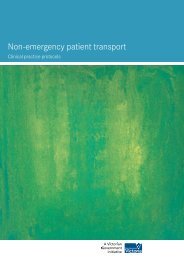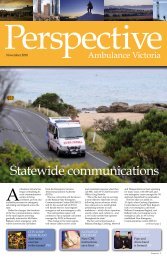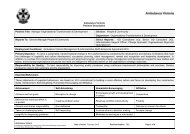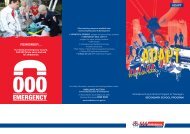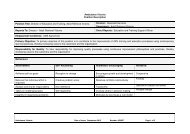AMBULANCE VICTORIA STRATEGIC PLAN 2010 â 2012
AMBULANCE VICTORIA STRATEGIC PLAN 2010 â 2012
AMBULANCE VICTORIA STRATEGIC PLAN 2010 â 2012
You also want an ePaper? Increase the reach of your titles
YUMPU automatically turns print PDFs into web optimized ePapers that Google loves.
PARTNERS FOR LIFE<br />
<strong>AMBULANCE</strong> <strong>VICTORIA</strong><br />
<strong>STRATEGIC</strong> <strong>PLAN</strong> <strong>2010</strong> – <strong>2012</strong>
1. Ambulance Victoria’s Role<br />
Ambulance Victoria is a critical link in Victoria’s health care system. AV provides<br />
pre-hospital care for patients experiencing medical emergencies, and medical<br />
transport by road and air to ensure both emergency and non-emergency<br />
patients access the appropriate level of health care. The overriding aim of<br />
the organisation is to improve the health outcomes of Victorians. In summary,<br />
Ambulance Victoria’s role is to:<br />
Improve the health of the Victorian community<br />
by providing high quality pre-hospital care and<br />
medical transport<br />
2. Overview of Services<br />
AV operates across the State, with major administrative centres in Melbourne<br />
and Ballarat. We have more than 3,000 career employees and almost 1,000<br />
volunteers, with over 220 road ambulance response locations. Air ambulance<br />
services (fixed wing and helicopter) cover the entire State.<br />
AV’s primary focus is to deliver services that meet the needs of our patients,<br />
their families and carers, and a range of organisations using our services<br />
(including public and private hospitals, the Transport Accident Commission,<br />
WorkCover and other health bodies).<br />
AV’s Services include:<br />
• Emergency medical response and pre-hospital care<br />
• Emergency medical transport by road or air<br />
• Non-emergency patient transport (including road and air<br />
stretcher transport and clinic transport for walking and<br />
wheelchair patients)<br />
• Major incident management and response<br />
• Retrieval of critically ill adult patients<br />
(including advice and bed coordination)<br />
• Assistance for ambulance patients to access appropriate<br />
care when paramedic care or transport is not required<br />
• Support for other health services in communities where<br />
the full range of services are not easily accessible<br />
• Community education in pre-ambulance arrival emergency care<br />
• The Ambulance Membership Scheme (ambulance insurance)<br />
1
3. Principles<br />
AV is committed to a set of ten principles, which provide a guiding framework for<br />
our service delivery to the community and for our internal operations.<br />
AV is committed to:<br />
1. Providing an appropriate response to all requests for service<br />
2. Developing our services to improve patient outcomes, based on the best<br />
available evidence<br />
3. Delivering services efficiently and cost effectively<br />
4. Collaborating with other service providers and the community to improve<br />
health system performance<br />
5. Minimising risks to the safety of patients and staff<br />
6. Safeguarding patient confidentiality and privacy<br />
7. Identifying and addressing community concerns about our services<br />
8. Respecting the values of all members of the community<br />
9. Recognising and valuing our people and their contributions<br />
10. Encouraging and providing opportunities for our people to develop.<br />
4. Strategic Objectives<br />
2. Foster staff development and well-being<br />
Effective service delivery is critically dependent on the skills and<br />
well-being of AV’s staff and volunteers. Minimising the risks to staff health<br />
and safety and encouraging the professional development of all staff are key<br />
organisational commitments.<br />
3. Develop organisational systems and resources to support improved<br />
service delivery<br />
Service delivery is becoming increasingly complex and dependent on more<br />
sophisticated support systems. Ensuring information and business systems<br />
continue to evolve is an essential part of delivering better services to the community.<br />
4. Strengthen community relationships and promote community initiatives<br />
and policy to improve patient outcomes<br />
AV is committed to building on its relationships with all parts of the Victorian<br />
community, to ensure that it understands and responds appropriately to the full<br />
diversity of community needs. Initiatives to develop community capability and<br />
awareness can make an important contribution to improving health outcomes.<br />
AV’s overriding aim of improving health outcomes for Victorians is underpinned<br />
by four strategic objectives, relating to service delivery, staff well-being,<br />
organisational systems and community relationships.<br />
1. Improve service quality and efficiency to better meet patient needs<br />
Continuing development of service quality to ensure patient needs are being met<br />
is fundamental to delivering improved health outcomes. Improved efficiency and<br />
better health system integration can also play a significant role in enabling more<br />
effective service delivery.<br />
2
AV Strategic Framework<br />
These strategic objectives shape AV’s response to the planning environment, as indicated in the diagram below. In the following two sections, the issues and themes,<br />
which provide the framework for development of detailed strategies, are discussed.<br />
AV role and principles<br />
Strategic objectives<br />
Improve Service<br />
Quality & Efficiency<br />
Foster Staff<br />
Development &<br />
Welfare<br />
Develop Systems &<br />
Resources<br />
Strengthen<br />
Community<br />
Relationships &<br />
Promote Initiatives<br />
Planning environment and issues<br />
Strategic themes<br />
• Demand Management<br />
• Process Efficiency<br />
• Health System Integration<br />
• Emergency Services Coordination<br />
• Standard & Scope of Care<br />
• Workforce Capability<br />
• Workforce Health & Safety<br />
• Workforce Well-being<br />
• Performance Monitoring<br />
• Information Management<br />
• Financial Management<br />
• Business Systems & Processes<br />
• Research<br />
• Environmental Sustainability<br />
• Community Capability & Awareness<br />
• Community Relationships & Accountability<br />
• Policy & System Development<br />
3
5. The Planning Environment<br />
Eleven key challenges have been identified, which AV will need to address<br />
during the planning period and beyond.<br />
Increasing demand for services<br />
Ambulance services in Victoria have been under stress as a result of continuing<br />
strong growth in demand for more than a decade. Since 1999-2000, ambulance<br />
caseload in Victoria has grown by an average of 5.1 per cent per annum, with both<br />
emergency and non-emergency incidents increasing by nearly 65 per cent. Other<br />
ambulance services around the world are experiencing similar demand pressures.<br />
Demand management has been an important focus for more than five years.<br />
The referral system for lower priority 000 callers in Melbourne has played<br />
an important role in controlling demand, with 8 percent of callers receiving an<br />
alternative to an emergency ambulance dispatch which better meets their needs.<br />
There is scope for expansion of the service and exploration of new emergency<br />
demand management initiatives. Management of non-emergency demand,<br />
and ensuring appropriate allocation of resources to meet patient needs will also<br />
be a priority. These strategies will assist in moderating growth, but increasing<br />
demand is expected to remain a key challenge through the planning period.<br />
The drivers of ambulance demand are similar to those affecting demand for most<br />
other health services. These include demographic change (ageing and population<br />
growth), which accounts for about 25 per cent of the increase in emergency<br />
demand. Trends in the health of the community play a key role, notably the<br />
increasing burden of chronic disease. Other factors also include changes in<br />
medical practice and patient management (e.g. the trend to early discharge<br />
and treatment in the community), social changes (e.g. the increasing number<br />
of people living alone), reduced accessibility to other health services in some<br />
areas (especially general practitioners) and rising community expectations.<br />
Growth has slowed in the last eighteen months, but there is no reason to believe<br />
that the long-term trend has changed. Large numbers of seriously ill patients<br />
(about 60 per cent of triage category 1 to 3 patients in Melbourne) are not<br />
transported to hospital emergency departments by ambulance, indicating there<br />
is significant potential for further increases in demand.<br />
4
Health System development<br />
Ambulance service delivery in Victoria has become an increasingly<br />
well-integrated part of the wider health system in recent years. This process<br />
will continue during the planning period, placing new demands on AV as well<br />
as creating new opportunities to improve services.<br />
There is a clear trend of increasing specialisation of hospital facilities for high<br />
acuity patients, driven by infrastructure costs and the clinical benefits of high<br />
levels of exposure for practitioners. Timely access to these facilities can have<br />
a significant bearing on patient outcome. This may involve ambulances bypassing<br />
the closest hospital to transport a patient to the most appropriate level<br />
of care as quickly as possible. Victoria’s system for managing major trauma is<br />
a well established example of this approach.<br />
Transmission of clinical information from the scene can also assist in<br />
reducing the time to access definitive care by facilitating early activation of<br />
specialist hospital teams. The recent introduction of ECG transmission for<br />
Acute Coronary Syndrome patients in southeast Melbourne, Geelong and<br />
the Southern Calder region has yielded impressive reductions in the time to<br />
definitive treatment, and more widespread implementation is now occurring.<br />
Improved system approaches for stroke patients is another likely development<br />
during the planning period.<br />
There is a long-term trend for reduced length of stay in hospital and a wide<br />
range of demand management strategies designed to prevent or minimise<br />
hospitalisation have been implemented in recent years.<br />
At the same time, there is increasing pressure on primary care services.<br />
As noted above, access to a general practitioner is difficult in some areas,<br />
particularly in rural Victoria.<br />
These changes tend to increase ambulance demand, but there is potential<br />
for paramedics to play a part in managing this demand more effectively.<br />
A number of ambulance services have introduced paramedic or emergency care<br />
practitioner roles in recent years, generally on a trial basis. There is significant<br />
variation in how these roles have been defined, but most involve an extension<br />
of the paramedic scope of practice, with an emphasis on increased assessment,<br />
referral and primary care skills. In Victoria, new roles have been developed in<br />
two remote communities focused on increased support for the local community,<br />
but with no change in clinical practice.<br />
Further exploration of the relevance of these new models of care will be an<br />
important priority during the planning period, focusing on the potential to<br />
improve both ambulance service delivery and wider health system performance.<br />
Hospital specialisation also tends to increase the requirement for patient<br />
transfers between facilities. AV’s air ambulance and adult retrieval services<br />
play a critical role in high acuity transfers, particularly in rural Victoria.<br />
Coordination of these patient movements can be complex and further<br />
development of systems to minimise delays will be a continuing focus for AV.<br />
A second important system trend affecting ambulance services is an increasing<br />
emphasis on care in the community as an alternative to hospital care.<br />
5
Equity in Service Delivery<br />
There are inherent difficulties in the provision of ambulance services in remote<br />
areas and areas with lower population densities. The Government’s response<br />
time targets reflect these difficulties, with one target for population centres of<br />
more than 7,500 people, and a somewhat lesser target for the State overall.<br />
Continuing improvements in air ambulance and retrieval systems, including<br />
the introduction of two new helicopters in 2009, will assist in providing better<br />
access to appropriate levels of care across the State.<br />
Nevertheless, a number of key areas have been identified where differentials<br />
in service standards are of particular concern. Cardiac arrest survival rates in<br />
rural areas are well below those achieved in the metropolitan area. This is not<br />
surprising given the importance of rapid response in cardiac arrest outcomes.<br />
However, a more complete understanding of the reasons for the difference is<br />
needed and new strategies to improve performance need to be developed.<br />
Call taking, dispatch and ambulance communications systems play a critical<br />
role in the quality of service delivery. There have been important improvements<br />
in these systems across the State in recent years, but rural call taking and<br />
dispatch systems have been well below best practice standards. The transition<br />
to an integrated statewide system operated by the Emergency Services<br />
Telecommunications Authority has commenced and completion of this work<br />
is a key priority for the planning period.<br />
Another important focus will be further development of an integrated statewide<br />
major incident management system, ensuring there is appropriate capability in<br />
all parts of the State.<br />
Risk of major incidents<br />
AV’s major incident system has been tested by a number of recent events,<br />
including the 2009 bushfires and heatwave period, and has proved its<br />
effectiveness. However, learning from these experiences to strengthen<br />
systems is essential to ensure an appropriate level of preparedness for<br />
response to all types of incident (including pandemic) is maintained.<br />
Monitoring risk and close collaboration with the relevant planning and<br />
response agencies at all levels of government are cornerstones of the system.<br />
Significant progress has been made in strengthening national collaboration,<br />
but further development of these links remains in a priority for development<br />
of the future system. Another key aspect is the ability to maintain normal<br />
services while managing a major incident, especially if it is prolonged.<br />
Evidence Based Practice<br />
The introduction of the Victorian Ambulance Clinical Information System<br />
was one of the most significant ambulance initiatives in the State in the last<br />
five years. VACIS provides a rich source of clinical data which can assist<br />
in driving the development of clinical practice and education. A number of<br />
other Australian services are now using VACIS, creating the opportunity for<br />
national sharing of consistent data. Linkages with hospital data are also<br />
being established to provide a more complete picture of patient outcomes.<br />
Ensuring the full benefits of this data are realised is an on-going priority.<br />
More generally, quality systems and performance monitoring will continue<br />
to evolve, with particular focus on patient outcome measures. Further<br />
development of AV’s role in pre-hospital research, usually in partnership<br />
with universities or other health services, will also assist in strengthening<br />
the evidence base for service improvement.<br />
6
Advances in information and technology<br />
Recent developments in information management systems have created new<br />
opportunities to drive performance improvements, but significant challenges<br />
remain. Key priorities include the integration of a number of the systems<br />
inherited from AV’s predecessor organisations, increased real time performance<br />
reporting, wider dissemination of geographic information and improving access<br />
to information for in-field managers. Real time data linkages with hospitals and<br />
greater use of decision support technologies have the potential to significantly<br />
improve operational processes and system performance.<br />
Resource Levels<br />
The Government provided a major injection of new funding for AV in 2008-<br />
2009, enabling significant recruitment for additional road response resources<br />
and the introduction of two new ambulance helicopters for the State. Further<br />
resource increases have been announced in <strong>2010</strong>. However, the demands on<br />
the organisation are continuing to grow and there is increasing competition for<br />
scarce resources within the health sector and beyond.<br />
Continuing improvement in the efficiency of operations is imperative in such<br />
a resource constrained environment. This will include maintaining the current<br />
focus on improving processes for patient handover at hospital emergency<br />
departments and further development of more dynamic deployment of response<br />
units. Complementing the focus on efficiency, strategies to protect and enhance<br />
revenue (especially from the Membership Scheme) will need to be pursued.<br />
Organisational Consolidation<br />
AV commenced operations on 1 July 2008, and integration of the key processes<br />
and systems of its predecessor organisations is now well advanced. However,<br />
a number of significant challenges remain to consolidate the transition process.<br />
These include further development of internal communications processes and<br />
completion of the transition to statewide information and business systems.<br />
An important benefit of the creation of the new organisation is the opportunity<br />
it provides for the refinement of existing processes and systems.<br />
7
Workforce demographics and expectations<br />
One of the most significant recent changes affecting ambulance services has<br />
been the move from training of paramedics following their employment to<br />
recruitment of graduate paramedics who have already completed a university<br />
degree. This change necessitates a new focus on workforce planning and liaison<br />
with the universities to ensure AV’s needs can be met. It has also required<br />
the development of programs to support the transition from university to the<br />
operational environment, and further evolution of these programs is expected.<br />
There has been a major emphasis on improving the health, safety and well-being<br />
of the workforce in recent years, and this will continue with further development of<br />
systems to facilitate early intervention and identification of the root causes<br />
of problems.<br />
The new recruitment and education model is also affecting workforce<br />
demographics, with increasing numbers of younger paramedics and women<br />
employed. At the same time, the number of paramedics in older age cohorts<br />
(over 50) is also increasing, especially in rural areas.<br />
These changes, as well as more general social trends, are affecting workforce<br />
attitudes and expectations. In particular, staff concerns about work/life balance<br />
will need to be addressed if AV is to remain an employer of choice. This is<br />
likely to involve increased access to part-time work and continuing development<br />
of alternative roster options. Promoting a constructive culture and further<br />
developing internal communications and consultation will also assist in meeting<br />
emerging staff expectations and improving organisational effectiveness.<br />
The availability of appropriate opportunities for professional development<br />
is another key aspect of meeting legitimate staff expectations, as well as<br />
strengthening organisational capability and facilitating succession planning.<br />
The focus on workforce development includes ensuring that opportunities are<br />
available for volunteers, especially those wishing to become career paramedics.<br />
8
Community expectations and capabilities<br />
There is a clear recognition in the Victorian community of the contribution<br />
paramedics make to its well-being. However, there are opportunities to<br />
improve services and increase access for specific communities through<br />
a better understanding of their needs.<br />
There have been a number of recent initiatives to improve links with<br />
Culturally and Linguistically Diverse communities and the Aboriginal<br />
community and to improve staff awareness of community diversity.<br />
Work will continue with these groups to further strengthen relationships;<br />
collaborations with patient groups with special clinical needs will also<br />
be extended. Working with the Department of Health and local<br />
communities to identify opportunities to improve ambulance services<br />
and contribute to better health system performance in specific<br />
geographic locations will be another important priority.<br />
Community feedback can also be a major driver of service improvement. A statewide<br />
system to capture complaints and compliments has been established, and ensuring<br />
an appropriate response to community concerns is a key organisational commitment.<br />
Environmental responsibilities<br />
Environmental change has the potential to impact on AV service delivery, most<br />
obviously by increasing the risk of major incidents such as bushfire or pandemic.<br />
More subtle impacts on the patterns of demand may also occur. These impacts<br />
clearly need to be factored into AV planning.<br />
At the same time, AV has placed increasing emphasis on implementing more<br />
environmentally sustainable practices. However, there is significant scope for<br />
improvement to ensure the organisation meets appropriate environmental targets.<br />
AV’s auxiliaries provide an important link with many local communities,<br />
and will continue to play a key role in supporting the provision of<br />
ambulance services in regional areas. Engagement with the community<br />
has also been focused on improving community capability and<br />
preparedness to manage an emergency. Current programs include<br />
targeted promotion of CPR skills and a range of schools programs,<br />
and these will continue to develop.<br />
There are more than twenty five Community Emergency Response Teams<br />
across the State, providing invaluable access to early initial treatment and<br />
support for career paramedics. Ambulance Community Officers also play<br />
a critical role in AV’s emergency response in more remote areas. Further<br />
developing support systems to ensure the sustainability of AV’s volunteer<br />
response capability will be a high priority during the planning period.<br />
9
6. Strategic Framework<br />
A set of strategic themes, each linked to one of four strategic objectives set out in section 4, complete the framework for the Strategic Plan<br />
The strategic themes identify the primary aim of the specific initiatives within the plan. Each of the themes is related to one or more of the key issues outlined in the<br />
previous section, and the initiatives linked to the theme are designed to address these issues.<br />
Objectives Strategic themes Key issues<br />
1. Improve service quality and<br />
efficiency to better meet patient needs<br />
1.1 Demand management:<br />
Improve matching of patient needs & services<br />
1.2 Process efficiency:<br />
Increase the efficiency of resource use to deliver<br />
improved services<br />
1.3 Health System integration:<br />
Further develop collaboration with other health service<br />
providers to improve health system performance<br />
1.4 Emergency Services coordination:<br />
Further develop collaboration with emergency service<br />
organisations to improve effectiveness of ambulance<br />
service delivery<br />
• Increasing demand for service<br />
• Resource levels<br />
• Community expectations<br />
• Health System developments<br />
• Resource levels<br />
• Advances in technology<br />
• Equity in service delivery<br />
• Risk of major incidents<br />
• Environmental responsibilities<br />
• Health System developments<br />
• Evidence based practice<br />
• Community expectations<br />
• Advances in technology<br />
• Risk of major incidents<br />
• Equity in service delivery<br />
• Community expectations<br />
1.5 Standard and scope of care:<br />
Enhance clinical care to improve patient outcome<br />
• Evidence based practice<br />
• Equity in service delivery<br />
• Health System developments<br />
10
Objectives Strategic themes Key issues<br />
2. Foster workforce development<br />
and well-being<br />
3. Develop organisational systems<br />
and resources to support improved<br />
service delivery<br />
2.1 Workforce capability:<br />
Support workforce development to increase organisational<br />
effectiveness<br />
2.2 Workforce health and safety:<br />
Improve workforce health & safety<br />
2.3 Workforce wellbeing:<br />
Further develop working environment to promote<br />
workforce well-being<br />
3.1 Performance Monitoring<br />
Refine measurement of performance to drive improved<br />
service delivery<br />
3.2 Information Management<br />
Further develop information systems to support<br />
improvements in service delivery<br />
3.3 Financial Management<br />
Strengthen the organisation’s financial position to support<br />
service delivery development<br />
• Workforce expectations<br />
• Evidence based practice<br />
• Advances in technology<br />
• Community expectations<br />
• Workforce expectations<br />
• Community expectations<br />
• Workforce expectations<br />
• Community expectations<br />
• Community expectations<br />
• Resource levels<br />
• Evidence based practice<br />
• Organisational consolidation<br />
• Advances in technology<br />
• Organisational consolidation<br />
• Resource levels<br />
• Organisational consolidation<br />
3.4 Business Systems and processes:<br />
Further develop business systems to support consistency<br />
and quality of service<br />
• Resource levels<br />
• Advances in technology<br />
• Organisational consolidation<br />
11
Objectives Strategic themes Key issues<br />
3. Develop organisational systems<br />
and resources to support improved<br />
service delivery (continued)<br />
3.5 Research:<br />
Increase research to support innovation in service delivery<br />
3.6 Environmental Sustainability:<br />
Reduce the environmental impact of AV activities<br />
• Evidence based practice<br />
• Health system developments<br />
• Community expectations<br />
• Environmental responsibilities<br />
4. Strengthen community<br />
relationships and promote community<br />
initiatives and policy to improve<br />
patient outcomes<br />
4.1 Community capability and awareness:<br />
Increase community awareness and skills to manage<br />
medical emergencies and collaborations with the community<br />
to improve patient outcomes<br />
4.2 Community relationships and accountability:<br />
Strengthen relationships with the community,<br />
improve understanding of the AV role and fulfil broader<br />
social responsibilities<br />
• Community expectations<br />
• Increasing demand for service<br />
• Workforce expectations<br />
• Resource levels<br />
• Community expectations<br />
• Environmental responsibilities<br />
4.3 Policy and system development:<br />
Further develop the ambulance role in contributing to<br />
broader health policy and systems<br />
• Health system developments<br />
• Increasing demand for service<br />
• Resource levels<br />
12
7. Strategic Initiatives <strong>2010</strong> to <strong>2012</strong><br />
Strategic initiatives have been developed to address the four organisational objectives and the aims expressed in the strategic themes. Target outcomes have<br />
been specified for each of the strategic initiatives. The initiatives and targets are described below, grouped according to the relevant AV service delivery area.<br />
1. Improve service quality and efficiency to better meet patient needs<br />
Emergency Response<br />
Strategic themes Strategies Outcomes<br />
Demand management:<br />
Improve matching of patient needs<br />
and services<br />
• Continue to refine 000 call prioritisation and ensure<br />
consistency of prioritisation statewide<br />
• Further develop the metropolitan Referral Service,<br />
increasing the referral options available and the scope of<br />
calls handled, and extend the Service statewide<br />
Improved identification of patient needs at the time of<br />
000 call for better targeted response<br />
Increased availability of appropriate alternatives to<br />
emergency ambulance response for lower priority<br />
000 callers<br />
• Undertake further analysis of the drivers of demand<br />
and work with DH to identify new demand management<br />
strategies, including strategies to improve service delivery<br />
to specific patient categories and improved links to<br />
primary care services<br />
Development of innovative strategies to address demand<br />
• Collaborate with residential aged care and other service<br />
providers to ensure a more appropriate ambulance response<br />
to residential aged care facilities<br />
More appropriate matching of response to the needs<br />
of residential aged care staff<br />
• Review planning criteria and methodology for<br />
emergency response resources in rural and remote areas<br />
Equitable basis for prioritising investment in response<br />
resources<br />
• Develop a long-term plan for statewide emergency<br />
response resources, taking into account demographic<br />
change and other drivers of demand<br />
Sufficient emergency response capacity to meet<br />
demand and achieve performance targets<br />
13
Strategic themes Strategies Outcomes<br />
Process efficiency:<br />
Increase the efficiency of resource<br />
use to deliver improved services<br />
• Improve the efficiency of the response process by:<br />
> Reducing case times<br />
> Improving the efficiency of logistic support processes<br />
> More dynamic deployment of resource units, building on<br />
current use of the Optima Live decision support system<br />
> Improving the management of urgent (Code 2) cases<br />
> Improving the efficiency of the interface with hospitals<br />
• Review dispatch rules (in conjunction with refinement<br />
of 000 call prioritisation), and ensure consistency of<br />
dispatch practice statewide<br />
• Complete implementation of a new operational<br />
front-line management model<br />
• Transfer rural call taking and dispatch to a single<br />
Communications Centre operated by ESTA, using a<br />
new Computer Aided Dispatch system<br />
• Continue to work with ESTA to improve call taking<br />
and dispatch processes<br />
• Develop and implement a statewide rostering system<br />
and paramedic placement model<br />
• Refine coordination processes for the management<br />
of time critical patient transfers<br />
Increased availability of response units and improved<br />
response times<br />
Better matching of dispatch with patient needs and<br />
more effective use of resources<br />
More effective management and improved<br />
operational performance<br />
More efficient and effective rural call taking and dispatch<br />
More efficient and effective call taking and dispatch<br />
More cost effective use of operational workforce and<br />
improved consistency of service delivery<br />
More efficient and timely transfer of time critical patients<br />
14
Strategic themes Strategies Outcomes<br />
Health system integration:<br />
Further develop collaboration with<br />
other health service providers to<br />
improve system performance<br />
• In conjunction with DH and the major health services,<br />
develop and implement improved processes for selection<br />
of hospital destinations<br />
• In conjunction with health services, further develop and<br />
implement systems for en route transmission of clinical<br />
information to receiving hospitals to enable early activation<br />
of the hospital response<br />
Better access for patients to definitive care<br />
Improved access for patients to definitive care<br />
• Continue development and implementation of an<br />
integrated strategy for acute coronary care patients,<br />
including early access to primary coronary angioplasty<br />
services and in-field thrombolysis where appropriate<br />
• Identify patient care pathways which provide a potential<br />
alternative to attendance at a hospital ED and explore<br />
options to improve their accessibility to paramedics<br />
Improved outcomes for acute coronary care patients<br />
Earlier access for patients to appropriate care<br />
• Work with DH and health services to evaluate and<br />
refine the current ambulance role in the response to<br />
mental health patients<br />
Improved service delivery for mental health patients<br />
• Work with DH regions to develop and implement strategies<br />
for improved integration and coordination of ambulance<br />
and health services, including co-location with hospitals<br />
where appropriate<br />
Improved integration with regional health services<br />
• Extend the use of Rapid Sequence Intubation (RSI)<br />
for brain-injured patients statewide<br />
Improved outcomes for brain-injured patients<br />
15
Strategic themes Strategies Outcomes<br />
Emergency services coordination:<br />
Further develop collaboration with<br />
emergency service organisations to<br />
improve effectiveness of service delivery<br />
Standard and scope of care:<br />
Enhance clinical care to improve<br />
patient outcomes<br />
• Evaluate the pilot Country Fire Authority Emergency<br />
Medical Response program in outer Melbourne (involving<br />
simultaneous dispatch of AV and CFA resources to<br />
suspected cardiac arrest cases) and, subject to the outcome,<br />
implement the EMR program in appropriate areas statewide<br />
• Further develop the AV Clinical Risk Management System,<br />
including sentinel event and clinical incident systems<br />
• Strengthen systems for review of the Clinical Practice<br />
Guidelines by drawing on VACIS data, including<br />
establishment of links with hospital (and other) data to assist<br />
outcome analysis<br />
Improved cardiac arrest outcomes<br />
Identification of opportunities for system improvement<br />
Stronger evidence base for clinical practice<br />
• Improve systems to facilitate the clinical development of<br />
paramedics based on VACIS data<br />
• Review the current paramedic scope of practice and<br />
develop appropriate new model(s) of paramedic practice,<br />
taking into account the needs of the specific communities<br />
served by AV, health system developments and experience<br />
in other jurisdictions<br />
Improved clinical support and development<br />
for paramedics<br />
Evaluation of new models of paramedic practice to<br />
support improved health system performance and<br />
(if appropriate) initial implementation of new model(s)<br />
• Investigate statewide variation in cardiac arrest outcomes<br />
and develop strategies to reduce differences<br />
Improved cardiac arrest outcomes<br />
16
Non-Emergency Transport<br />
Strategic themes Strategies Outcomes<br />
Demand management:<br />
Improve matching of patient needs<br />
and services<br />
• In conjunction with DH, review and refine the current<br />
criteria for use of non-emergency transport<br />
Improved matching of resource type with patient need<br />
Process efficiency:<br />
Increase the efficiency of resource use<br />
to deliver improved services<br />
• Develop and implement a statewide non-emergency<br />
services strategy, with a particular focus on options for rural<br />
service delivery and appropriate use of non-emergency<br />
resources for high acuity transports<br />
• Complete statewide implementation of a non-emergency<br />
scheduling and vectoring system and introduce improved<br />
measures of non-emergency performance<br />
More efficient fleet management and improved<br />
service delivery<br />
Health system integration:<br />
Further develop collaboration with other<br />
health service providers to improve<br />
system performance<br />
• Explore options to assist hospital discharge processes in<br />
collaboration with DH and health services<br />
• Develop relationships with non-government agencies to<br />
assist with rural low acuity patient transport<br />
Improved patient flow in hospitals<br />
Improved allocation of resources and service delivery<br />
to rural and low acuity patients<br />
17
Air Ambulance<br />
Strategic themes Strategies Outcomes<br />
Demand management:<br />
Improve matching of patient needs<br />
and services<br />
Process efficiency:<br />
Increase the efficiency of resource<br />
use to delivery improved services<br />
• Continue to refine dispatch criteria to ensure appropriate<br />
use of aircraft and improve availability statewide<br />
• Develop and implement a strategy for the long term<br />
development of air ambulance operations and implement<br />
the strategy progressively<br />
Better matching of dispatch with patient needs and more<br />
effective use of resources<br />
More efficient and effective air ambulance operations<br />
Health system integration:<br />
Further develop collaboration with<br />
other health service providers to<br />
improve system performance<br />
• Work with rural and regional health services to improve<br />
the timeliness of aircraft activation<br />
• Work with rural and regional health services to improve<br />
access to helipads and landing sites<br />
Earlier access for patients to appropriate care<br />
Earlier access for patients to appropriate care<br />
Retrieval Services<br />
Strategic themes Strategies Outcomes<br />
Process efficiency:<br />
Increase the efficiency of resource use<br />
to deliver improved service<br />
• Implement the ARV service improvement plan and<br />
benchmark performance with other jurisdictions<br />
Improved service delivery for adult medical retrievals<br />
Health system integration:<br />
Further develop collaboration with other<br />
health service providers to improve<br />
system performance<br />
• Collaborate with DH and the non-adult retrieval services<br />
(peri-natal, neo-natal and paediatric) to improve the<br />
interface between the services and air ambulance<br />
Improved service delivery for non-adult medical<br />
retrievals<br />
• Continue to work with DH and health services to improve<br />
the management of access to critical care beds<br />
Improved accessibility of critical care beds<br />
18
Major Incident Preparedness<br />
Strategic themes Strategies Outcomes<br />
Demand management:<br />
Improve matching of patient needs<br />
and services<br />
Process efficiency:<br />
Increase the efficiency of resource use to<br />
deliver improved services<br />
• Continue close monitoring of the risks of all types of major<br />
incident, and ensure appropriate AV capability is developed<br />
and maintained<br />
• Continue development of major incident response<br />
processes to ensure statewide consistency of approach<br />
AV major incident capability meeting Government<br />
and community expectations<br />
Integrated and consistent statewide response to<br />
major incidents<br />
Health system integration:<br />
Further develop collaboration with other<br />
health service providers to improve<br />
system performance<br />
• Continue major incident planning, liaison and coordination<br />
with all relevant national and State response and planning<br />
bodies<br />
Improved coordination of major incident response<br />
agencies and strengthened system capability to<br />
respond to a major incident<br />
Emergency services coordination:<br />
Further develop collaboration with<br />
emergency service organisations to<br />
improve effectiveness of service delivery<br />
• Continue work with inter-state ambulance services (via the<br />
Council of Ambulance Authorities) and emergency services<br />
organisations to ensure appropriate ambulance involvement<br />
in national major incident planning<br />
Improved coordination of major incident response<br />
agencies and strengthened system capability to<br />
respond to a major incident<br />
19
2. Foster workforce development and well-being<br />
Strategic themes Strategies Outcomes<br />
Workforce capability:<br />
Support workforce development to<br />
increase organisational effectiveness<br />
• Develop a long-term workforce plan which identifies future<br />
organisational workforce needs and assists universities to<br />
plan student intakes<br />
• Support national initiatives on paramedic course<br />
accreditation through the Council of Ambulance Authorities,<br />
and continue AV liaison with universities regarding their<br />
selection procedures and curricula of paramedic courses<br />
Assured future supply of appropriately qualified<br />
paramedics<br />
Continuing development of paramedic education to meet<br />
service delivery needs<br />
• Review the current program for graduate paramedic<br />
recruits and explore options to improve their transition into<br />
the workforce<br />
Improved pathway for paramedic graduates to obtain<br />
the experience required to practice independently<br />
• Promote the career development of paramedics, including<br />
progression to specialist roles (MICA, Clinical Instructor,<br />
Clinical Specialist, Clinical Support Officer, Flight Paramedic<br />
etc)<br />
Improved AV clinical performance and workforce<br />
satisfaction<br />
• Further expand opportunities for all members of the<br />
workforce to develop their management and technical skills<br />
and strengthen the succession planning framework<br />
Improved management capability and succession<br />
planning<br />
• Develop and implement new strategies to attract and retain<br />
paramedics in regional and rural areas<br />
Improved retention of rural operational workforce<br />
20
Strategic themes Strategies Outcomes<br />
Workforce capability:<br />
Support workforce development to<br />
increase organisational effectiveness<br />
(continued)<br />
• Further develop strategies and support processes to ensure<br />
the engagement, sustainability, reward and recognition of the<br />
volunteer workforce<br />
• Further support the professional development of Ambulance<br />
Community Officers and Community Emergency Responders<br />
(including development of pathways to paramedic education)<br />
• Further develop and implement flexible learning options<br />
(e.g. on-line systems)<br />
• Further develop programs to promote workforce awareness<br />
of the needs of CALD and Aboriginal communities<br />
• Promote continuing development of a constructive and<br />
consistent organisational culture, including further<br />
development of mechanisms for workforce engagement,<br />
communication and consultation<br />
Improved integration of volunteers with AV operations<br />
and better patient outcomes in communities served by<br />
volunteers<br />
Improved level of service to rural communities and<br />
supply of paramedics in rural locations<br />
Improved workforce access to training and education<br />
programs<br />
Improved service delivery for CALD and Aboriginal<br />
communities<br />
Constructive attitudes and behaviours focused on<br />
common objectives<br />
Workforce health and safety:<br />
Improve workforce health and safety<br />
• Develop and implement an integrated AV Occupational<br />
Health and Safety Strategic Plan, with a focus on:<br />
> Health check and immunisation programs<br />
> Early intervention<br />
> Appropriateness of equipment<br />
> Manual handling injuries<br />
> Managing aggression/assault<br />
> Stress<br />
> Fatigue<br />
> Monitoring of trends and root cause analysis to identify<br />
underlying issues<br />
> Benchmarking with other jurisdictions<br />
Reduced workforce injuries and lost time<br />
21
Strategic themes Strategies Outcomes<br />
Workforce well-being:<br />
Further develop working environment to<br />
promote workforce well-being<br />
• Develop further initiatives to provide greater flexibility in<br />
working arrangements, including increased availability<br />
of part time options<br />
• Continue exploration of alternative rosters, taking into<br />
account workforce well-being impacts and service delivery<br />
requirements<br />
• Continue program of branch refurbishment to improve<br />
employees’ working environment<br />
Increased opportunities for a better work/life balance<br />
Identification of a suite of preferred future rosters<br />
Improved working environment for both operational<br />
and administrative workforce<br />
3. Develop organisational systems and resources to improve service delivery<br />
Strategic themes Strategies Outcomes<br />
Performance monitoring:<br />
Refine measurement of performance to<br />
drive improved service<br />
• Continue development of AV performance measures and<br />
targets (including operational, clinical and support services<br />
measures) and extend benchmarking with comparable<br />
services<br />
• In consultation with ESTA, further develop CAD<br />
performance measures for ambulance, reflecting both the<br />
speed and quality of call-taking and dispatch<br />
More complete view of AV performance and value<br />
Refined set of call-taking and dispatch performance<br />
measures, reflecting service delivery needs<br />
• Establish links with external data sources to facilitate<br />
further development of patient outcome measures<br />
• Work with DH and health services to develop measures of<br />
health system performance (including an AV component)<br />
Improved understanding of AV impact on<br />
patient outcomes<br />
More complete view of system performance and<br />
AV contribution<br />
22
Strategic themes Strategies Outcomes<br />
Information mangement:<br />
Further develop systems to support<br />
improvements in service delivery<br />
• Continue the strategic development of information systems<br />
(as per the Information Management Strategic Plan)<br />
with a focus on:<br />
> Identification of future information requirements<br />
> Further integration of data from internal and external sources<br />
> Extending use of GIS data<br />
> Provision of real time management information<br />
> Real time transmission and receipt of clinical and management<br />
data with hospitals (e.g. pre-arrival ECG, projected arrivals,<br />
hospital status)<br />
> Infrastructure requirements to support systems development<br />
> Organisational consistency<br />
• Complete implementation of integrated statewide<br />
information systems for key processes, including<br />
financial, human resource, payroll, time and attendance,<br />
and clinical systems<br />
Increased accessibility, completeness, reliability and<br />
timeliness of management information to support<br />
improved decision-making<br />
Consistent management processes<br />
Financial mangement:<br />
Strengthen the organisation’s financial<br />
position to support service development<br />
• Explore opportunities to refine the current funding model and<br />
increase clarity about future funding<br />
• Continue development of strategies to improve the<br />
performance of the Membership Scheme (including the<br />
possible introduction of new products)<br />
• Develop and implement strategies to increase the capacity<br />
to fund new initiatives internally<br />
Increased certainty about future financial position<br />
to support longer term service planning<br />
Improved profitability of the Membership Scheme<br />
Increased ability to implement service innovations<br />
23
Strategic themes Strategies Outcomes<br />
Business systems and processes:<br />
Further develop business systems to<br />
support consistency and quality of<br />
service delivery<br />
Research:<br />
Increase research to support innovation in<br />
service delivery<br />
• Further develop AV quality and risk management systems,<br />
including business continuity systems<br />
• Explore opportunities to establish further data links with<br />
business partners<br />
• Implement improved logistics management systems (for fleet,<br />
medical equipment, supplies etc)<br />
• Ensure AV clinical data is effectively used to support<br />
innovations in practice and promote the national roll-out<br />
of VACIS to facilitate national ambulance research and<br />
benchmarking<br />
• Continue to build research collaborations with universities,<br />
health services and other research bodies<br />
• Monitor international research and innovation in ambulance<br />
and the broader health sector to identify opportunities to<br />
improve service delivery<br />
Increased reliability and consistency of service delivery<br />
Increased efficiency of business processes<br />
Increased efficiency and effectiveness of operations<br />
support processes<br />
Further evidence-based development of practice<br />
Increased research to identify clinical and operational<br />
service improvement opportunities<br />
Early identification of options to improve services<br />
Environmental responsibilities:<br />
Reduce the environmental impact of<br />
AV activities<br />
• Implement an organisational plan to reduce the<br />
environmental impact of AV activities<br />
Reduced environmental impacts and improved<br />
environmental sustainability<br />
24
4. Strengthen community relationships and promote community initiatives and policy to improve patient outcomes<br />
Strategic themes Strategies Outcomes<br />
Community capability and awareness:<br />
Increase community awareness and<br />
skills to manage medical emergencies<br />
and collaborations with the community<br />
to improve patient outcomes<br />
• Continue to develop community CPR skills, with a focus<br />
on at risk groups, CALD communities and the Aboriginal<br />
community<br />
• Collaborate with partner organisations (including<br />
community safety organisations and first aid providers) to<br />
reduce preventable injuries and increase the community<br />
uptake of first aid training<br />
Increased community capability in CPR, contributing<br />
to improved cardiac arrest survival rates<br />
Increased community capability in injury prevention and<br />
first aid<br />
• Develop strategies for community engagement to improve<br />
the community/ambulance response for specific clinical<br />
conditions (e.g. asthma, stroke, diabetes, mental health<br />
and cardiovascular)<br />
Improved patient outcomes<br />
Community relationships and<br />
accountability:<br />
Strengthen relationships with the<br />
community, improve understanding<br />
of the AV role and fulfil broad social<br />
responsibilities<br />
• Further develop mechanisms for community engagement,<br />
including the Community Advisory Committee and auxiliaries<br />
• Continue to develop community relationships to improve<br />
access and equity, with a particular focus on:<br />
> CALD communities<br />
> the Aboriginal community (including developement<br />
of an AV Reconciliation Action Plan)<br />
> the aged<br />
> people with disabilities<br />
> people with chronic diseases<br />
> specific clinical conditions<br />
(eg asthma, stroke, diabetes, mental health,<br />
cardiovascular)<br />
Improved understanding of community needs<br />
Improved responsiveness to specific community needs<br />
and improved patient outcomes<br />
25
Strategic themes Strategies Outcomes<br />
Community relationships and<br />
accountability:<br />
(continued)<br />
Health policy and system<br />
development:<br />
Further develop the ambulance role in<br />
improving the health system performance<br />
• Explore options to increase public awareness of appropriate<br />
ambulance use<br />
• Refine public reporting of AV performance, including<br />
additional reporting of clinical outcomes and clinical incidents<br />
• Provide policy input to DH to ensure unintended<br />
impacts of health system developments on ambulance<br />
service delivery are minimised<br />
• Collaborate with DH and health services to identify<br />
opportunities and develop strategies to improve the health<br />
system response for specific categories of high acuity patients<br />
• Strengthen links with the primary health care sector and<br />
explore options to improve service delivery via partnerships<br />
with other service providers, particularly general practitioners<br />
More appropriate use of ambulance services<br />
Increased public accountability<br />
More effective and appropriate use of<br />
ambulance services<br />
Better coordination of ambulance and health<br />
services and improved outcomes for high<br />
acuity patients<br />
More appropriate use of ambulance services and<br />
improved patient outcomes<br />
• Work through the Council of Ambulance Authorities to<br />
improve the recognition of the ambulance role and issues<br />
at a national level<br />
Increased national recognition of the ambulance<br />
contribution to health system performance<br />
26
8. Performance measurement<br />
AV monitors its organisational performance using a suite of performance<br />
indicators grouped into four broad categories, which are closely aligned to<br />
the four strategic objectives outlined above:<br />
8.1 Service delivery standards<br />
These performance indicators measure the quality of AV service delivery<br />
Performance<br />
Indicator<br />
Measures<br />
> Service delivery standards<br />
> Workforce development and well-being<br />
> Resource management and cost effectiveness<br />
> Health system and community capability<br />
Further development of the indicator suite is proposed during the planning<br />
period, with particular focus on refinement and expansion of service delivery<br />
indicators including measures of response time, clinical outcome and nonemergency<br />
performance (see Section 7 above). Where necessary, more<br />
specific measures will also be introduced to evaluate the effectiveness of<br />
each of the strategies outlined in Section 7.<br />
Existing performance indicators and related measurement definitions are<br />
detailed below. Specific targets are set for each measure every year in the<br />
AV Annual Plan.<br />
Call taking and<br />
dispatching times<br />
Emergency<br />
response times<br />
Standard of care<br />
Percentage of 000 calls answered<br />
within 5 seconds<br />
Percentage of Code 1 incidents with total<br />
timeto dispatch within 150 seconds<br />
Percentage os suspected cardiac arrest<br />
incidents (Priority 0) responded to within<br />
13 minutes<br />
Percentage of Code 1 incidents responded<br />
to within 15 minutes<br />
Percentage of Code 1 incidents responded<br />
to within 15 minutes in urban centres with<br />
population greater than 7,500<br />
Percentage of audited cases meeting<br />
standards (compliance with Clinical<br />
Practice guidelines)<br />
> emergency cases<br />
> non-emergency cases<br />
> CERT<br />
27
Performance<br />
Indicator<br />
Measures<br />
8.2 Workforce development and well-being<br />
These performance indicators measure the effectiveness of strategies to promote<br />
workforce development, health and safety<br />
Patient outcomes<br />
1<br />
Percentage of adult cardiac arrest patients<br />
with vital signs at hospital<br />
Percentage of adult cardiac arrests patients<br />
surviving to hospital discharge<br />
1<br />
Performance<br />
Indicator<br />
Measures<br />
Mean reduction in pain score for<br />
> ischaemic chest pain<br />
> traumatic pain<br />
Workforce<br />
education and<br />
training<br />
Average days of training per employee per year<br />
> operational employees<br />
> non-operational employees<br />
Percentage of patients with initial severe cardiac<br />
relief or traumatic pain who receive significant<br />
pain relief<br />
Workforce health and<br />
safety<br />
Sick leave rate<br />
> operational employees<br />
> non-operational employees<br />
Percentage of potential major trauma patients<br />
(non-trapped) with scene time less than or<br />
equal to 20 minutes<br />
Average annual days lost through work-related injury<br />
per operational employee<br />
Patient satisfaction<br />
Percentage of patients (or their carers)<br />
satisfied or very satisfied with service<br />
Average full shift overtime per week (operational<br />
employees)<br />
Number of complaints per thousand cases<br />
> total complaints<br />
> substantiated complaints<br />
Percentage of members satisfied or very<br />
satisfied with the Membership Scheme<br />
Workforce<br />
satisfaction<br />
Percentage of workforce satisfied (or better) working<br />
at AV<br />
> operational employees<br />
> non-operational employees<br />
1. Adult cardiac arrests not witnessed by a paramedic, presenting in VF/VT where resuscitation attempted<br />
28
8.3 Resource management and cost effectiveness<br />
These performance indicators measure the effectiveness of resource and cost<br />
management and of financial strategies to support service delivery<br />
8.4 Health system & community capability<br />
These performance indicators measure the effectiveness of other health care<br />
providers, partner organisations and the broader community in contributing to<br />
emergency outcomes<br />
Performance<br />
Indicator<br />
Measures<br />
Performance<br />
Indicator<br />
Measures<br />
Service delivery costs<br />
Overhead costs<br />
Cost per case for each service delivery category<br />
> emergency road<br />
> non-emergency road<br />
> air ambulance rotary wing<br />
> air ambulance fixed wing<br />
> adult retrieval<br />
Percentage of operating expenditure spent on<br />
administration<br />
Management of low<br />
priority 000 callers<br />
First responder<br />
programs<br />
Percentage of 000 callers receiving health<br />
advice or service from another health<br />
provider as an alternative to emergency<br />
ambulance response<br />
Percentage of suspected cardiac arrest cases<br />
(Priority 0) where (non-AV) first responder<br />
arrives first<br />
Generation of<br />
non-government<br />
revenue<br />
Financial liquidity<br />
Percentage of population (excluding pensioners<br />
and health care card owners), who are members<br />
of the Membership Scheme<br />
Administrative cost per member of the<br />
Membership Scheme<br />
• Quick asset ratio<br />
• Current asset ratio<br />
Community first aid<br />
skills<br />
Community<br />
satisfaction<br />
Health sector<br />
satisfaction<br />
Percentage of incidents where CERT is<br />
dispatched and arrives first<br />
Percentage of witnessed cardiac arrests where<br />
bystander CPR is undertaken<br />
Percentage of community satisfied or very<br />
satisfied with AV performance<br />
Percentage of health sector stakeholders<br />
satisfied with AV performance<br />
29
9. Ambulance Victoria in <strong>2012</strong><br />
AV’s strategies to <strong>2012</strong> build on the significant development of Victoria’s<br />
ambulance services which have occurred over the last ten years. The creation<br />
of a single statewide service in 2008 was a major step in a continuing process<br />
of transformation. On-going work to ensure consistency and integration of<br />
services and systems will be a continuing theme during the planning period.<br />
Major developments in service delivery by <strong>2012</strong> will include:<br />
• Rationalisation of rural communications centres, and statewide consistency<br />
in call taking and dispatching<br />
• Progress towards more consistent patient outcomes across the State<br />
(particularly cardiac arrest outcomes)<br />
• Continuing improvement in coordination and integration with the broader<br />
health sector, including improved performance at the hospital interface and<br />
extension of referral options<br />
• Evaluation of options for extending the scope of paramedic practice and<br />
(if appropriate) initial implementation of new model(s)<br />
• More efficient and dynamic management of emergency response resources<br />
• Strengthening of statewide major incident response systems and capability<br />
• More consistent statewide approach to the provision of non-emergency<br />
patient transport<br />
• More efficient and effective air ambulance services<br />
• Improved levels of service for adult retrievals statewide.<br />
There will be a continuing focus on workforce development and well-being<br />
through the planning period. This will include promotion of a positive and<br />
consistent organisational culture and further development of mechanisms<br />
for workforce engagement and consultation.<br />
Strategies to minimise health and safety risks to the workforce will remain a<br />
key priority, and options to provide more flexible working arrangements will<br />
be developed. The program of facilities refurbishments will continue across<br />
the State.<br />
AV will work closely with the universities to ensure paramedic education<br />
meets organisational requirements and there is an appropriate future<br />
supply of qualified workforce.<br />
Organisational information systems will continue to evolve, with particular<br />
focus on integration of systems and data across the organisation, more<br />
real time reporting, more effective use of GIS data and better linkages<br />
with relevant external data.<br />
Use of VACIS data to support more evidence based approaches to clinical<br />
practice and training, and research to drive innovation will be significant<br />
priorities.<br />
Reducing AV’s environmental footprint will be an important objective for<br />
the planning period.<br />
AV is committed to further strengthening community relationships across<br />
the State, with a particular focus on improving its responsiveness to special<br />
needs and increasing the capability of communities to manage emergencies<br />
prior to ambulance arrival.<br />
30
Glossary & abbreviations<br />
ACO<br />
ARV<br />
AV<br />
CAA<br />
CAD<br />
CALD<br />
CERT<br />
CFA<br />
CPG<br />
DH<br />
Dispatch Code<br />
ECG<br />
ED<br />
EMA<br />
ESTA<br />
GIS<br />
MFB<br />
MICA<br />
MTS<br />
Single<br />
Responder<br />
Ambulance Community Officer<br />
Adult Retrieval Victoria<br />
Ambulance Victoria<br />
Council of Ambulance Authorities Australia<br />
Computer Aided Dispatch<br />
Culturally and Linguistically Diverse<br />
Community Emergency Response Team<br />
Country Fire Authority<br />
Clinical Practice Guidelines<br />
Department of Health<br />
Priority of ambulance dispatch (From 1 to 3; Code 1 means a<br />
time critical dispatch, with a response using lights and sirens)<br />
Electrocardiogram<br />
Hospital Emergency Department<br />
Emergency Management Australia<br />
Emergency Services Telecommunications Authority<br />
Geographic Information Systems<br />
Metropolitan Fire Brigade<br />
Mobile Intensive Care Ambulance<br />
Major Trauma Service (The Alfred Hospital, Royal Melbourne Hospital & Royal Children’s Hospital)<br />
MICA paramedic or Ambulance paramedic response unit<br />
without transport capability (usually a sedan)<br />
Triage Category Priority assigned to patients in hospital emergency departments (from 1 to 5)<br />
VACIS<br />
Victoria Ambulance Clinical Information System<br />
VACU<br />
Victorian Ambulance Counselling Unit<br />
31


